华尔思Oracle OCM直通车课程大纲教材
- 格式:pdf
- 大小:312.86 KB
- 文档页数:7
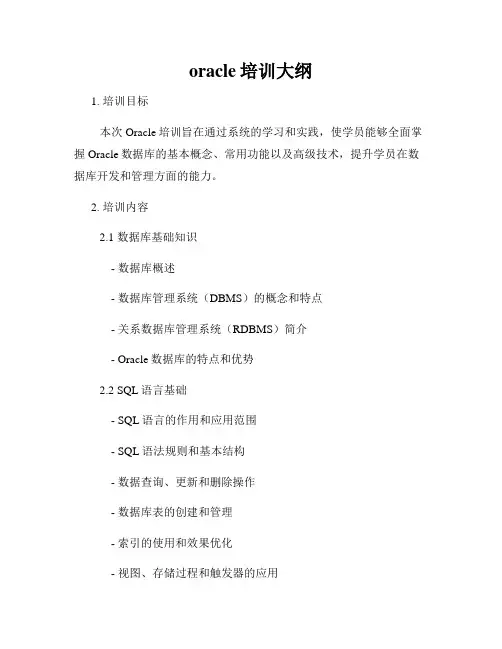
oracle培训大纲1. 培训目标本次Oracle培训旨在通过系统的学习和实践,使学员能够全面掌握Oracle数据库的基本概念、常用功能以及高级技术,提升学员在数据库开发和管理方面的能力。
2. 培训内容2.1 数据库基础知识- 数据库概述- 数据库管理系统(DBMS)的概念和特点- 关系数据库管理系统(RDBMS)简介- Oracle数据库的特点和优势2.2 SQL语言基础- SQL语言的作用和应用范围- SQL语法规则和基本结构- 数据查询、更新和删除操作- 数据库表的创建和管理- 索引的使用和效果优化- 视图、存储过程和触发器的应用2.3 数据库高级技术- 高级SQL查询和优化- 复杂查询的应用- 数据库设计和规范化- 数据库安全性和权限管理 - 备份和恢复策略- 性能监控和调优2.4 PL/SQL编程语言- PL/SQL语言的概述- 变量、条件和循环语句 - 游标和异常处理- 存储过程和函数的开发 - 包和触发器的应用2.5 数据库性能优化- SQL优化技巧和策略- 索引和查询优化- 统计信息和执行计划分析- 优化器参数配置和调整- 性能监测和评估工具3. 培训方式本次培训将采用多种方式,包括讲座、案例分析、实际操作演练和练习题等。
学员将通过实际操作和练习,巩固所学知识,并提高实际应用能力。
4. 培训师资我们的培训师资团队由经验丰富的Oracle数据库专家组成,他们既具备扎实的理论基础,又有丰富的实际项目经验。
他们将为学员提供全方位的专业指导和支持。
5. 培训时间和地点培训时间:预计为期两个月,每周安排2-3次培训课程,每次2小时。
培训地点:我们将提供配备完善的计算机设备和数据库环境的培训场所。
6. 培训考核为了确保学员的学习效果和培训质量,我们将设立考核环节。
学员需要通过考试或项目实践来评估其对Oracle数据库的掌握程度。
7. 培训证书学员成功完成培训并通过考核后,将获得由我们颁发的培训证书,证明其在Oracle数据库方面的专业能力。
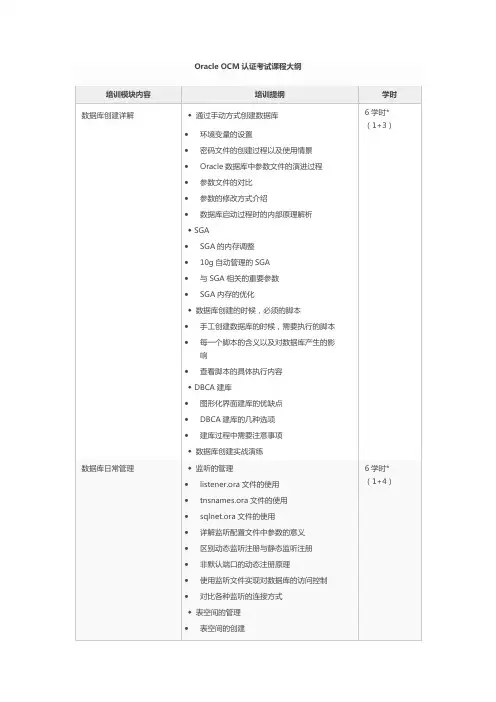
Oracle OCM认证考试课程大纲培训模块内容培训提纲学时6学时*(1+3)数据库创建详解◆通过手动方式创建数据库∙环境变量的设置∙密码文件的创建过程以及使用情景∙Oracle数据库中参数文件的演进过程∙参数文件的对比∙参数的修改方式介绍∙数据库启动过程时的内部原理解析◆ SGA∙SGA的内存调整∙10g自动管理的SGA∙与SGA相关的重要参数∙SGA内存的优化◆数据库创建的时候,必须的脚本∙手工创建数据库的时候,需要执行的脚本∙每一个脚本的含义以及对数据库产生的影响∙查看脚本的具体执行内容◆ DBCA建库∙图形化界面建库的优缺点∙DBCA建库的几种选项∙建库过程中需要注意事项◆数据库创建实战演练6学时*(1+4)数据库日常管理◆监听的管理∙listener.ora文件的使用∙tnsnames.ora文件的使用∙sqlnet.ora文件的使用∙详解监听配置文件中参数的意义∙区别动态监听注册与静态监听注册∙非默认端口的动态注册原理∙使用监听文件实现对数据库的访问控制∙对比各种监听的连接方式◆表空间的管理∙表空间的创建∙大文件表空间的使用,以及参数的介绍∙对比大文件表空间和小文件表空间∙表空间的扩展∙表空间的删除∙系统表空间的剖析∙表空间管理的演进:数据库管理表空间,本地管理表空间∙日志组的管理:添加日志组,为日志组添加成员等◆数据库默认属性的修改∙数据库的默认临时表空间,默认用户表空间的设置◆ Oracle数据库基于参数的优化◆控制文件∙控制文件的内容剖析∙控制文件的管理与备份∙控制文件的多路复用◆数据库的冷备∙冷备的概念∙冷备和热备的优缺点对比∙冷备的限制条件Enterprise Manager Grid Control◆ Grid Control体系结构◆部署Enterprise Manager Grid Control◆部署配置Enterprise Manager Grid ControlAgent◆使用Grid Control对数据库进行性能监控◆使用Grid Control创建表空间◆使用Grid Control对数据库进行日常运维∙创建job∙设置表空间警告阈值∙进行参数的调整◆使用Grid Control进行RMAN相关的备份∙创建Catalog∙配置Target∙一些参数的调整◆使用Grid Control创建分区表以及分区索引◆使用Grid Control创建含有特殊字段的表◆使用Grid Control 进行传输表空间的操作6学时*(1+3)◆ Grid Control的删除方法6学时*(1+3)备份恢复◆逻辑备份◆物理备份◆备份方式的对比◆ RMAN∙配置RMAN工作环境∙RMAN Catalog的原理∙配置恢复目录数据库∙RMAN 中常用参数的介绍以及作用∙压缩备份∙备份集与备份片的比较∙用RMAN备份/恢复数据库◆ Flashback闪回数据库技术∙Oracle数据库闪回技术浅析∙闪回技术分类∙对比各种闪回技术∙设置Flashback参数∙配置闪回区域∙监视Flashback数据库日志和统计信息∙执行Flashback Database操作∙配置闪回区域6学时*(1+3)数据库仓库◆对某种故障的处理∙问题所展示出来的现象描述∙所包含的原理∙该故障的解决方案◆系统表空间剖析◆物化视图∙物化视图的刷新及其原理∙物化视图的参数介绍∙物化视图的去重∙物化视图的跨库更新∙用物化视图进行备份∙物化视图重写◆ DB link的剖析◆ SQLLDR解析∙sqlldr中参数的含义∙sqlldr的使用方式∙案例演示sqlldr的使用过程∙sqlldr在使用过程中需要注意的知识点◆外部表∙外部表实现原理∙外部表的参数介绍∙对比sqlldr与datapump两种驱动方式∙跨库读取数据库运维◆传输表空间技术∙数据泵要点剖析∙表空间的状态以及各自的使用场景∙约束检查∙Directory的创建、授权∙EXPDP/IMPDP的参数透析∙用交互式命令行实现传输表空间技术◆分区技术∙分区表的创建∙分区表的分类∙分区索引的创建∙分区索引的分类∙全局索引与本地索引的对比∙对索引的维护◆ Oracle数据库的特殊字段∙几种常用的特殊字段∙每一种特殊字段的使用情景∙使用特殊字段的注意事项∙创建含有CLOB,BLOB字段的表∙创建含有时间戳字段的表∙创建引用rowid字段的表◆审计∙审计的用途∙细粒度审计的深入剖析∙触发审计的条件∙查看审计的触发记录◆索引监控6学时*(1.5+4)∙使用情景∙开启监控∙查看监控,了解索引的使用情况∙关闭监控◆闪回技术的案例精解∙案例:闪回查询∙案例:闪回删除∙案例:不完全恢复数据库优化◆检查点∙检查点的原理∙检查点的分类∙检查点对数据库性能的影响∙检查点的优化◆ Oracle内存优化∙优化共享池∙优化缓冲区高速缓存∙自动共享内存∙优化I/O∙优化PGA◆索引∙对各种索引的解析∙不同索引的使用情景∙索引的优缺点◆在线重定义技术∙内部原理∙对比在线重定义与Move操作◆优化工具介绍∙最根本的性能信息工具:数据库数据字典和动态性能视图∙Alert Log与Trace Files对性能故障诊断的帮助∙诊断性能问题的法宝:Statspack与AWR∙Statspack安装与使用∙AWR使用∙10g新增加的自动化监控、调优工具——ADDM 6学时*(1.5+4)◆ I/O优化∙数据库数据文件∙重做日志文件、∙归档文件的I/O性能特点分析和优化原则∙存储级的I/O性能考虑∙使用多DBWR进程增加I/O能力∙异步I/O的性能考虑∙LGWR与ARC进程的优化∙加速归档的方法◆竞争优化∙锁存器(LATCH)竞争优化∙锁竞争的解决∙回滚段竞争优化◆应用存储优化∙应用存储参数的优化∙选择合适的数据存储方法◆应用语句优化∙SQL语句的处理过程∙SQL语句解析的优化∙锁定执行计划Oracle Clusterware的安装◆简介6学时*(1+3)◆ Oracle Clusterware安装和配置∙Oracle RAC 安装说明∙执行RAC预安装任务∙手工建立信任关系的方法∙设置集群的环境变量∙安装Oracle Clusterware◆ Oracle software的安装◆ RAC软件安装∙安装和配置自动存储管理(ASM)∙安装Oracle数据库软件∙执行数据库创建前任务◆创建RAC数据库∙创建集群数据库∙执行创建数据库之后的任务◆在RAC中管理备份和恢复∙配置RAC数据库,以使用ARCHIVELOG模式和快速恢复区∙为RAC环境配置RMAN◆在RAC中的日常操作∙关闭数据库∙启动数据库∙表空间和数据库文件的维护∙日志信息的查看方式∙服务的运行状况Data Guard ◆ Oracle容灾技术Data Guard6学时*(1+3)∙Oracle Data Guard技术概述∙手工方式安装、配置和管理Oracle物理Data Guard∙使用Grid Control工具安装、配置和管理Oracle物理Data Guard∙使用Grid Control工具对Oracle DataGuard进行健康检查∙Oracle Data Guard三种数据保护模式之间比较及总结∙Oracle Data Guard主备Switchover切换演练∙OMF方式下Oracle Data Guard配置方式及特点∙Oracle Data Guard常见问题解析◆逻辑Data Guard的工作原理◆对比物理Data Guard与逻辑Data Guard◆对比Failover与Switchover备注:6学时*(1+3)代表每天的上课时间是6学时,括号内的第一个数字1代表知识点讲授是1天,第二个数字3代表攻击训练和冲刺辅导是3天。
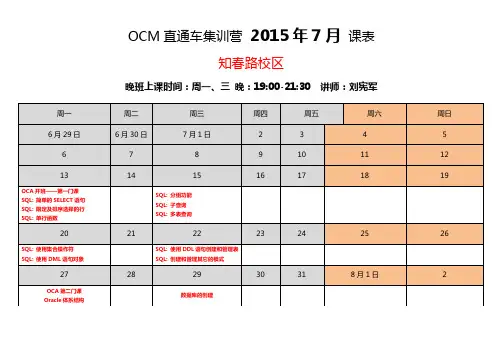
OCM直通车集训营2015年7月课表知春路校区晚班上课时间:周一、三晚:19:00-21:30 讲师:刘宪军周一周二周三周四周五周六周日6月29日6月30日7月1日 2 3 4 56 7 8 9 10 11 1213 14 15 16 17 18 19OCA开班——第一门课SQL: 简单的SELECT语句SQL: 限定及排序选择的行SQL: 单行函数SQL: 分组功能SQL: 子查询SQL: 多表查询20 21 22 23 24 25 26SQL: 使用集合操作符SQL: 使用DML语句对象SQL: 使用DDL语句创建和管理表SQL: 创建和管理其它的模式27 28 29 30 31 8月1日 2OCA第二门课Oracle体系结构数据库的创建OCM直通车集训营2015年8月课表知春路校区晚班上课时间:周一、三晚:19:00-21:30 讲师:刘宪军周一周二周三周四周五周六周日7月27日28 29 30 31 8月1日 2安装oracle软件配置oracle网络环境管理ASM实例3 4 5 6 7 8 9数据并发与控制管理UNDO数据实施oracle数据库的审计数据库的前瞻性维护10 11 12 13 14 15 16数据库的性能管理备份恢复的概念执行用户管理的备份17 18 19 20 21 22 23 执行用户管理的恢复数据的迁移24 25 26 27 28 29 30休息休息OCM直通车集训营2015年9月课表知春路校区晚班上课时间:周一、三晚:19:00-21:30 讲师:刘宪军周一周二周三周四周五周六周日8月31日 1 2 3 4 5 6OCA开班——第一门课SQL: 简单的SELECT语句SQL: 限定及排序选择的行SQL: 单行函数SQL: 分组功能SQL: 子查询SQL: 多表查询7 8 9 10 11 12 13SQL: 使用集合操作符SQL: 使用DML语句对象SQL: 使用DDL语句创建和管理表SQL: 创建和管理其它的模式14 15 16 17 18 19 20OCA第二门课Oracle体系结构数据库的创建21 22 23 24 25 26 27 安装oracle软件配置oracle网络环境管理ASM实例28 29 30 10月1日 2 3 4OCM 直通车集训营 2015年10月 课表知春路校区晚班上课时间:周一、三 晚:19:00-21:30 讲师:刘宪军数据并发与控制 管理UNDO 数据实施oracle 数据库的审计 数据库的前瞻性维护节假日 节假日 节假日 节假日周一 周二 周三 周四 周五 周六 周日 567891011节假日节假日节假日12131415161718数据库的性能管理备份恢复的概念 执行用户管理的备份192021222324 25执行用户管理的恢复数据的迁移26272829303111月1日休息休息OCM直通车集训营2015年11月课表知春路校区晚班上课时间:周一、三晚:19:00-21:30:刘宪军周一周二周三周四周五周六周日2 3 4 5 6 7 8OCP第三门课配置oracle数据库的恢复能力使用恢复目录配置备份设置创建RMAN备份转储和恢复任务使用RMAN完成恢复9 10 11 12 13 14 15监视和调整RMAN 诊断数据库使用闪回技术116 17 18 19 20 21 22使用闪回技术2实施闪回数据库管理内存23 24 25 26 27 28 29OCM 直通车集训营 2015年12月 课表知春路校区晚班上课时间:周一、三 晚:19:00-21:30 讲师:刘宪军管理数据库的性能 通过SQL 调整性能管理资源 使用调度3012月1日23456管理数据库的存储空间复制数据库周一 周二 周三 周四 周五 周六 周日 78910111213休息休息14151617181920OCM: RACOCM: RAC21222324252627OCM: RACOCM: RAC28 29 30 31OCM: RAC OCM: RACOCM直通车集训营2016年1月课表知春路校区晚班上课时间:周一、三晚:19:00-21:30 讲师:刘宪军周一周二周三周四周五周六周日1 2 3节假日节假日节假日4 5 6 7 8 9 10OCM: RAC OCM: RAC11 12 13 14 15 16 17OCM: RAC OCM: RAC18 19 20 21 22 23 24 OCM: DataGuard OCM: DataGuard25 26 27 28 29 30 31OCM: DataGuard OCM: DataGuardOCM直通车集训营2016年2月课表知春路校区晚班上课时间:周一、三晚:19:00-21:30 讲师:刘宪军周一周二周三周四周五周六周日1 2 3 4 5 6 7 OCM: DataGuard OCM: DataGuard 节假日8 9 10 11 12 13 14节假日节假日节假日节假日节假日节假日15 16 17 18 19 20 21 OCM: DataGuard OCM: DataGuard22 23 24 25 26 27 28 OCM: DataGuard OCM: DataGuard29。
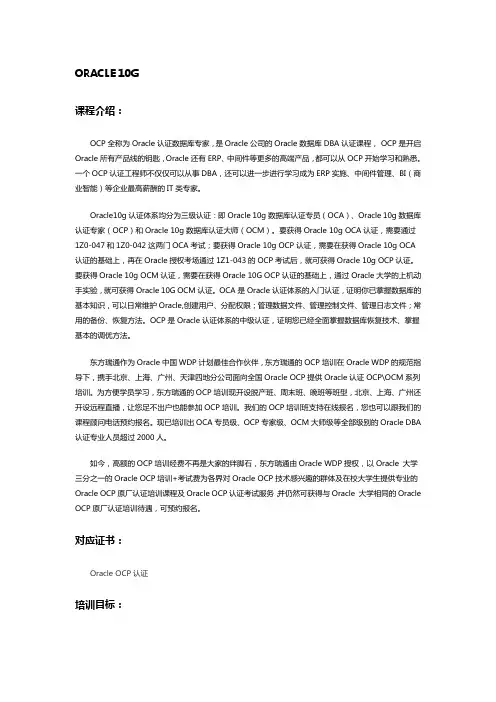
ORACLE 10G课程介绍:OCP全称为Oracle认证数据库专家,是Oracle公司的Oracle数据库DBA认证课程,OCP是开启Oracle所有产品线的钥匙,Oracle还有ERP、中间件等更多的高端产品,都可以从OCP开始学习和熟悉。
一个OCP认证工程师不仅仅可以从事DBA,还可以进一步进行学习成为ERP实施、中间件管理、BI(商业智能)等企业最高薪酬的IT类专家。
Oracle10g认证体系均分为三级认证:即Oracle 10g数据库认证专员(OCA)、Oracle 10g数据库认证专家(OCP)和Oracle 10g数据库认证大师(OCM)。
要获得Oracle 10g OCA认证,需要通过1Z0-047和1Z0-042这两门OCA考试;要获得Oracle 10g OCP认证,需要在获得Oracle 10g OCA 认证的基础上,再在Oracle授权考场通过1Z1-043的OCP考试后,就可获得Oracle 10g OCP认证。
要获得Oracle 10g OCM认证,需要在获得Oracle 10G OCP认证的基础上,通过Oracle大学的上机动手实验,就可获得Oracle 10G OCM认证。
OCA是Oracle认证体系的入门认证,证明你已掌握数据库的基本知识,可以日常维护Oracle,创建用户、分配权限;管理数据文件、管理控制文件、管理日志文件;常用的备份、恢复方法。
OCP是Oracle认证体系的中级认证,证明您已经全面掌握数据库恢复技术、掌握基本的调优方法。
东方瑞通作为Oracle中国WDP计划最佳合作伙伴,东方瑞通的OCP培训在Oracle WDP的规范指导下,携手北京、上海、广州、天津四地分公司面向全国Oracle OCP提供Oracle认证OCP\OCM系列培训。
为方便学员学习,东方瑞通的OCP培训现开设脱产班、周末班、晚班等班型,北京、上海、广州还开设远程直播,让您足不出户也能参加OCP培训。
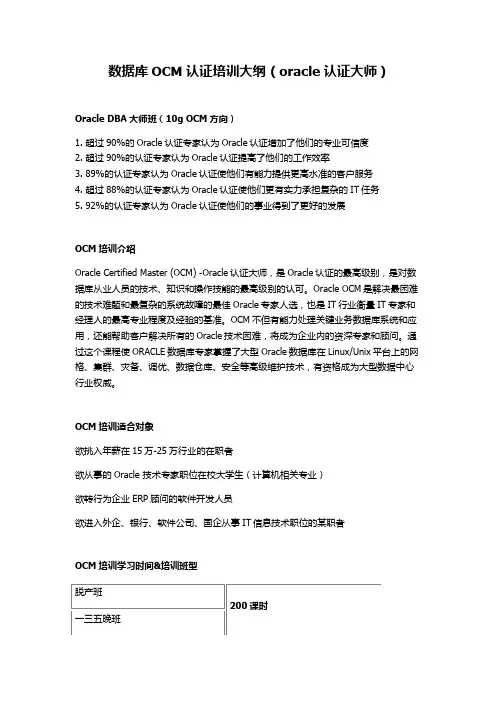
数据库OCM认证培训大纲(oracle认证大师)Oracle DBA大师班(10g OCM方向)1. 超过90%的Oracle认证专家认为Oracle认证增加了他们的专业可信度2. 超过90%的认证专家认为Oracle认证提高了他们的工作效率3. 89%的认证专家认为Oracle认证使他们有能力提供更高水准的客户服务4. 超过88%的认证专家认为Oracle认证使他们更有实力承担复杂的IT任务5. 92%的认证专家认为Oracle认证使他们的事业得到了更好的发展OCM培训介绍Oracle Certified Master (OCM) -Oracle认证大师,是Oracle认证的最高级别,是对数据库从业人员的技术、知识和操作技能的最高级别的认可。
Oracle OCM是解决最困难的技术难题和最复杂的系统故障的最佳Oracle专家人选,也是IT行业衡量IT专家和经理人的最高专业程度及经验的基准。
OCM不但有能力处理关键业务数据库系统和应用,还能帮助客户解决所有的Oracle技术困难,将成为企业内的资深专家和顾问。
通过这个课程使ORACLE数据库专家掌握了大型Oracle数据库在Linux/Unix平台上的网格、集群、灾备、调优、数据仓库、安全等高级维护技术,有资格成为大型数据中心行业权威。
OCM培训适合对象欲挑入年薪在15万-25万行业的在职者欲从事的Oracle 技术专家职位在校大学生(计算机相关专业)欲转行为企业ERP顾问的软件开发人员欲进入外企、银行、软件公司、国企从事IT信息技术职位的某职者OCM培训学习时间&培训班型OCM培训课程内容课程一:Oracle10g 服务器配置课程简介:通过本课程使的数据库工程技术人员能够了解OCM认证的考试形式、时间安排和注意事项,帮助学员掌握手工创建数据库和表空间,配置数据库监听器等任务。
课程内容:1. OCM考试简介2. 运用脚本创建数据库2. 确定和设置有关数据库架构的参数3. 条带化数据文件4. 创建与管理复用控制文件5. 大文件表空间管理6. 创建与管理多网络配置文件7. 监听器配置8. 共享数据库服务器的监听器配置9. 网络跟踪配置10. 管理Oracle 网络进程11.优化数据访问性能12. 临时、永久、UNDO表空间管理工具软件:Oracle 10g/11g Database 、Listener、SQL/PLUS课程二:Oracle10g网格计算与控制课程简介:Oracle网格计算使多组联网计算机能够组织到一起并按需进行共享,以满足不断变化的业务需求。
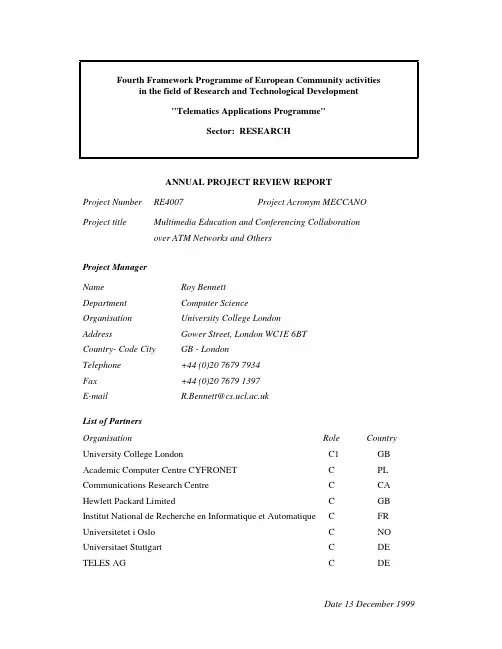
ANNUAL PROJECT REVIEW REPORTProject Number RE4007 Project Acronym MECCANO Project title Multimedia Education and Conferencing Collaborationover ATM Networks and OthersProject ManagerName Roy BennettDepartment Computer ScienceOrganisation University College LondonAddress Gower Street, London WC1E 6BTCountry- Code City GB - LondonTelephone +44 (0)20 7679 7934Fax +44 (0)20 7679 1397E-mail R.Bennett@List of PartnersOrganisation Role Country University College London C1 GB Academic Computer Centre CYFRONET C PL Communications Research Centre C CA Hewlett Packard Limited C GB Institut National de Recherche en Informatique et Automatique C FR Universitetet i Oslo C NO Universitaet Stuttgart C DE TELES AG C DEThis section should not normally exceed 20 pages in length and should draw the attention of the Annual Project Review to the key elements of the project. Supporting information should be included in annex.A.1 Objectives of the projectHow the work done has contributed to meeting the project objectives, whether the original objectives needrefocussing etc., to what extent have overall project objectives been met.The project objectives are reproduced below with our comments on the work done to meet them in italic.The objective of the project is to provide all the technology components, other than the data network itself, to support collaborative RTD through the deployment of enhanced tools for multimedia collaboration in Europe. The project will improve and deploy the existing toolsets with a particular application aim of distance education and of conferencing. The improvements will occur in many important aspects:• Better integration of the multimedia conferencing tools to make them easier to use by untrained users;Work has continued on the conference bus which is installed in RAT, Vic and the new gateway tool AudioGate. We have released a new version of the integrated interface for Windows, SGI and Solaris platforms.• Capability for optimum video, audio, shared workspace and applications sharing over heterogeneous bandwidths;Our approach to this has been twofold: in the video and audio tools we have introduced layered codecs which allow the tools to adapt to varying network conditions; in the network we have deployed gateways which can deliver media at rates to suit the bandwidth available to individual users.We have released a version of the video tools Vic and Rendez-Vous with layered codecs; Rendez-Vous has the capability to adapt dynamically to changing network changing. We have redesigned the UCL Transcoding Gateway (UTG) and are developing a new gateway at UiO. Major changes to the transcoder/multiplexer in RAT have contributed to both this and the new telephone to multicast gateway, AudioGate, which we have delivered this year.• Identify the additional support and management facilities required to meet and enhance the end-user applications;We have delivered R3.1 which describes the architecture of the MECCANO tools and other component and have completed R3.2, the preliminary report on their usability.• Inter-operable cross-platform support for many systems - UNIX workstations and PCsWe continue to provide support for almost all of our tools on Microsoft, Solaris and Irix platforms; many are also available on Linux and FreeBSD. We maintain the documentation for the tools, including Installation and User guides, in English, German and Polish.• Better support for the introduction and recording of multimedia information in conferences;We have developed an improved user interface for the MultiMedia Conference Recorder (MMCR) with a self-installing binary for the Windows platform. We have developed a CORBA wrapper for the Sun Media Centre content manager which is undergoing testing.• Support for network reservation and multicast deployment over concatenated networks technologies - mainly using IP - including packet-switched, ATM, SMDS, Direct Broadcast Satellite, mobile and ISDN;Some initial work has been done on network reservation in local research networks, but most of our work to address this objective has been in the area of multicast deployment over ATM and DBS networks. We are starting to work with wireless networks for mobile devices.• Improved inter-operation between workstations running the multicast Internet and normal ITU-T procedures;This activity, the start of which was initially delayed due to recruiting problems at UB and TELES, has made significant progress during this year with the introduction of the AudioGate gateway.• Integration of low-speed access facilities via intelligent packet filtering, multiplexing and transcoding gateways with distributed, secured, control;We have redesigned the UTG and are currently implementing the new design. A new RTSP-controlled gateway has been developed at UiO.• Capability of interworking between Internet multicast and ITU-T styles of end-station.We have developed and delivered an initial gateway to allow a user on the telephone network to join multicast multimedia conferences. We plan to extend this to allow interaction between H.323 workstations with video as well as audio communication.• Facilities for secure conferencing - with the keys distribution compatible with a large-scale CA infrastructure;We have delivered an improved version of secure SDR (2.6.1) as part of the first major software deliverable D.2 and have a later version (2.9) for delivery in D.3. In addition we have developed, and are using, a secure web server to launch secure conferences. This server, the Secure Conference Store, will be delivered in D.3. It is currently accessible from the UCL web site at https:///home/• Distributed measurement, monitoring and management of Resource Reservation and Quality of Service:Some initial work has been done on resource reservation in local research networks, but there is no European wide area testbed to which we have access. We are participating in the TF-TANT Quantum project in this area.• Conference announcement and invitation - including of private sessions - integrated with booking systems.We have continued to develop SDR, especially the secure version. The new gateway, AudioGate, has made use of the control features available with the Mbus to enable users of the telephone network to participate in multicast conferences. Our work in this area has recently concentrated on the provision of a secure, web-based server to allow the authenticated announcement of secure conferences with authenticated participants. This server can also be used for non-secureannouncement. We have participated fully in the work of the IETF on developing the invitation protocol SIP.Verification activities will be pursued both inside the project and in other Telematics projects which stress each of the technical activities. The following test all the tools over various network technologies and geographic regions.• Regular research seminars given from the sites of the partners - including North America We have delivered a number of seminars despite very adverse conditions in the European multicast network. The first series was reported in R8.1 and we have subsequently delivered a series of four recorded seminars during the summer.• Use in the research community, including over the national research networks of UKERNA, DFN, UNINETT, and CA*Net II of seminars, lectures, research collaboration and home working.Despite many difficulties with the European multicast infrastructure, we have continued to use the tools for meetings and seminars. Sometimes this has been possible only by the use of reflectors and such gateways as the UTG.• Use by at least 8 other Telematics, ESPRIT and ACTS projects and several national ones.Besides tools from MERCI and ICETEL projects, it will utilise results from ICE-CAR, current National, and EC projects.During the past year, the MECCANO tools have been used by many groups; the following have been supported by the project: CAIRN, ICB, ICE-CAR, Jagielonian University, K nowledge Network, PIPVIC, REDISE, Virtual Coffee Room, VIROR..Analysis of whether this year's objectives have been met.A.2 Work doneDescription of the main activities of the project in the reporting period. Give a brief description of the workundertaken within each of the work packages, with reference to the technical deliverables (list included in annex4) where the methodology and results are described in more detail. The executive summaries of all Public andProgramme level deliverables should be included in Annex 5.Describe any impact of current or emerging standards on the project's work and the actual or likely contribution of the project on the work of standardisation bodies.Use of budget resources will be summarised in the annex 1, 2 and 3.Workpackage 1: ManagementLeader: Peter Kirstein, UCLWe have held regular on-line meetings using the MECCANO tools – project meetings at 4-weekly intervals and technical meetings weekly. These have been less productive than we would have expected from our experiences with previous projects due to the continuing poor state of the European multicast infrastructure which we discuss below. We held project meetings at Hewlett-Packard Laboratories Bristol in January, at INRIA Sophia Antipolis in April, at the University of Bremen in June and at ACC Krakow in October. We have completed and delivered all deliverables to date, some a little later than we would have wished due to the difficulty of obtaining peer reviews. We have delivered all the bi-monthly management reports and the second Progress report, due in July.Problems encounteredNew Learning AS, an associate partner through UiO, has experienced a number of problems since the spring of this year and has been unable to contribute to the project as a result. The company expects to resume work on its contribution in the near future and we do not see this as having a major impact on the deliverables or their timing. We have brought this to the attention of the Commission over a period of months in the management reports.The multicast connectivity between the main European partners remains problematical, notwithstanding the new TEN-155 interconnects. Also, we have had consistent problems recently in connecting to ACC in Poland and to our Canadian partner, CRC, which has been unable to join our management meetings for many months.Workpackage 2: Activity with External GroupsLeader: Roy Bennett, UCLWe have continued our activities this year in the three main areas of interaction with external groups: demonstrations at relevant events, working with other projects to develop and/or validate our tools and working with international standards bodies. We were unfortunately forced to withdraw from our planned high quality conferencing demonstration prepared for the IST 99 event in Helsinki due to a lack of adequate bandwidth provision.Demonstrations30 November - 2 December 1998: IST 98 Vienna Information Society TechnologiesConference & Exhibition25-26 February 1999: The Launch of TEN 155 at the launch of the Fifth Framework programme, Essen (details in WP5 below).7-10 June 1999: TERENA-NORDUnet Networking Conference, LundWe manned a stand for the duration of the conference and presented a progress report on the project.11-13 October 1999: 5th International Conference on Safety in the Port Environment Environmental Protection and Information Technology, BremenUB demonstrated the conferencing system CONTRABAND that is based on MECCANO media tools (see http://www.ptc-bremen.de/). The demonstration showed how multiparty multimedia conferencing relying on MECCANO tools can be used for accident management and remote consultation, increasing safety and efficiency in sea transport application areas.Other ProjectsREDISEAs part of our cooperation with the Esprit project REDISE (see WP9), german installation and operation manuals have been written to help people to become familiar with NetMeeting, the MECCANO toolset and VNC (the Virtual Network Computer originally developed by Olivetti Research Labs)MECCANO tools were used in combination with NetMeeting to allow the operation of an expensive software package (which had been installed on a single site only) from remote sites. Due to the successful use of MECCANO tools in this engineering environment, RUS was invited to present the tools to local SMEs during a “REDISE Workshop”.Baden-Wurttemberg Research NetworkSome time ago, a working group was founded among the big universities in Baden-Wurttemberg to install the (network, hardware and software) infrastructure required to allow “ad-hoc” desktop multimedia conferences between scientists and engineers at these universities.In the context of this working group, RUS is pushing the multicast infrastructure and has contributed software providing monitoring of the multicast network (see WP5), software and manualsTEN-155During this reporting period, the MECCANO project acted in conjunction with ERCIM in the QUANTUM project as an alpha-tester for the Ten-155 Managed Bandwidth Service. This collaboration is elaborated in the report on Workpackage 5 below.During the official launch of the 5th Framework Programme and the opening of TEN-155 a presentation of MECCANO tools and concepts was given to Edelgard Bulmahn, the german minister for science and education, using the new TEN-155 VPN links. This presentation was given in cooperation with DANTE.Standards bodiesIETFWe provide co-chairs of the AVT, MMUSIC, SIP and UDLR Groups of the IETF.The project was represented at all four meetings of the IETF during the reporting period: 43 (7-11.12.98), 44 (15-19.3.99), 45 (12-16.7.99), 46 (8-12.11.99).We have helped to develop many Internet Drafts during this reporting period. Here we list the latest versions only, since many have been through several revisions. The following were submitted on work partially carried out in the MECCANO context: Duros, Dabbous, Izumiyama, Fujii, Zhang, “A Link Layer Tunneling Mechanism for Unidirectional Links”, draft-ietf-udlr-lltunnel-00.txt, February 1999Robinson, Stewart, “RTP Payload format for Shared Multicast Virtual Worlds (SMVW)”, draft-stewart-avt-00.txt, 25 June 1999.Ott, Kutscher & Bormann, "Capability description for group cooperation", draft-ott-mmusic-cap-00.txt , June 1999Ott, Perkins & Kutscher, "Requirements for Local Conference Control", draft-ott-mmusic-mbus-req-00.txt, June 1999Ott, Perkins & Kutscher, "A Message Bus for Conferencing Systems", draft-ott-mmusic-mbus-transport-00.txt, June 1999Ott, Perkins & Kutscher, "The Message Bus: Messages and Procedures", draft-ott-mmusic-mbus-semantics-00.txt, June 1999Perkins, “RTP Interoperability Statement”, draft-ietf-avt-rtp-interop-01.txt, 15 August 1999.Handley, Perkins & Whelan, “Session Announcement Protocol”, draft-ietf-mmusic-sap-v2-03.txt, 21 October 1999.Perkins, Rosenberg, Schulzrinne, “RTP Testing Strategies”, draft-ietf-avt-rtptest-02.txt, 21 October 1999.Civanlar, Basso, Casner, Herpel, Perkins, “RTP Payload Format for MPEG-4 Streams”, draft-ietf-avt-rtp-mpeg4-02.txt, 22 October 1999.Perkins, “Interactions between SDP and multicast scoping”, draft-perkins-sdp-scoping-00.txt, 22 October 1999.Casner, Schulzrinne, “RTP Profile for Audio and Video Conferences with Minimal Control”, draft-ietf-avt-profile-new-07.txt, 27 October 1999.Perkins, “RTP Audio/Video Profile Interoperability Statement”, draft-ietf-avt-profile-interop-00.txt, 28 October 1999.Handley, Crowcroft, Bormann, Ott, “The Internet Multimedia Conferencing Architecture”, draft-ietf-mmusic-confarch-02.txt, October 1999.The following has progressed from draft to RFC:Handley, Perkins, “Guidelines for Writers of RTP Payload Format Specifications”, RFC 2736, November 1999.ITU-TWe have made a core contribution on robust/redundant/fault-tolerant H.323 components (Oct 1999), leading the ad-hoc group discussion and drafting terms of reference for future work.H.323 Annex E: We have made contributions to this documentH.323 Annex F Simple Endpoint Types: Joerg Ott completed editorship and the recommendation was approved in May 1999.H.323 Annex R: We have made contributions to this documentWe have participated in the following meetings and conferences:16.12.98 ITU Workshop Multimedia over IP-based networks10-15.2.99: ITU-T H.32318-28.5.99: ITU-T SG 162-6.8.99: ITU-T Meeting2-6.8.99: ITU-T SG16 Q.11-15 Joint Rapporteurs Meeting in Berlin, hosted by TELES.Joint workDesign for capability syntax in the MEGACO WG of the IETF and ITU-T SG16 Q.14: Contributions by TELES as member of the design team.Other standards meetings attended13-14.1.99: ETSI Tiphon24.4.99: MPEG meeting27-29.9.99: VON ConferenceWorkpackage 3: Systems Architecture and DemonstratorsLeader: Peter Kirstein, UCLThe major effort of this workpackage was the production of the deliverable R3.1: Architecture of the MECCANO tools and other components. This report benefited from the contributions of many partners who, although not funded for work in the workpackage, had specific expertise and interest.At the January MECCANO meeting at Hewlett Packard, a re-assessment of HP’s role in MECCANO, undertaken in the light of the departure of Pat Baker, resulted in the agreement that Hewlett Packard would undertake an examination of the delivery of Multicast conferencing over Firewalls. The result of this activity was a report, entitled Approaches to Multicast over Firewalls, which was completed on 30 August and is available on the MECCANO project web site.We also produced as internal deliverable D3.2, a usability assessment of the MECCANO tools. This study attempted to define some basic usability requirements for desktop video conferencing and relate this to the MECCANO tools. The report was delivered in two parts Usability Assessment of the MECCANO Tools and Usability Requirements for Collaborative Environments, which also includes a discussion of other conferencing approaches and tools.Workpackage 4: Multimedia Conference componentsLeader: Thierry Turletti, INRIAMuch effort this year has been devoted to improving the tools in the toolset, implementing the Mbus in them and porting them to other platforms and to IPv6.Audio conferencingThe experimental version of RAT (4.x) was released for D4.2 and improvements have been made throughout the year. Bug-fix releases have been made of the stable version of RAT (v3.x) to provide for the needs of the projects which we support (eg PIPVIC2)A new version of FreePhone has been released including SIP and a novel optimal joint rate/error control scheme. We have been working on the improvements of the optimal FEC algorithm, in particular, work is ongoing concerning the sensitivity of the network characteristics estimators on the performance of the algorithm.Video conferencingWe have continued work on vic and have recently released an experimental version (2.8ucl-1.1.0) with support for layered coding.Shared workspaceWe have released several new versions of NTE, the latest being 1.7.0, which included support for other character sets than English - specifically Cyrillic for Russian Language teaching. Work has continued on the development of an improved design of this tool implementing a new protocol and an experimental version has been released recently. We have improved the AOFwb and AOFrec tools, in particular, the transmitting part, the audio recording feature and the graphical interface. New versions of the tools and the corresponding documentation are available in the public domain. We have also added download packages of recorded lectures. The tools have been tested and used in several seminars and lectures.Based on experiences with the Java-based shared whiteboard tool TeleDraw, we have developed TeleStore, a concept for “generic workspace sharing”. This tool intends to simplify the development of future workspace sharing tools by offering a flexible, extensible object-oriented platform which already implements the storage and communication facilities required for such applications. A TeleStore prototype is almost finished and will be available by end of the year.We have released a new version of the ReLaTe integrated interface for IRIX, Solaris and Windows.AnnouncementWe delivered SDR 2.6.1 in D4.2 and have since released new versions to fix security problems. The latest release is now 2.9. In conjunction with ICE-CAR we havedeveloped and SDP PARser (SPAR) which is in use by the project for conference announcement along with SDR.Video serverWe have been working on the Virtual Multimedia File System. An alpha version of the Scalable Video Distribution Architecture (SVDA) has been released, providing flexible hierarchical storage, booking, caching, real-time delivery and presentation for the needs of organization, indexing and retrieval of multimedia document collections with a "video-on-demand" interface.We have also worked on a Java MPEG-1 Player. It is based on the Java Media Framework and is an important part of SVDA system which enables users to play MPEG-1 live stream received from a video server. Additionally, SDR plugin mechanism for this component has been worked out and tested, enabling SDR users with installed plugin to receive MPEG-1 audio/video stream over multicast networks.Work has continued on the development of the user interface to the Multicast Conference Recorder (MMCR) and a redesign of the core recorder is under consideration.Multicast-Unicast ReflectorWe have been working on the RTSP-controllable multicast-to-unicast reflector architecture described in Deliverable R3.1 of WP3. It includes the following tools:1. Reflector engine and control unit ("reflector") which performs the actual packetforwarding between a multicast group and a set of unicast addresses.2. Announcement collector which is a simple session announcement database.3. Modified RTSP server having reflector control functionality, it forms a bridge toWWW integration of the multicast-unicast reflector.4. RTSP control unit ("Rtspc") is an RTSP client with a simple graphical interface. Tools 1-3 need to coexist and are referred to as "service provider tools", while only Rtspc must be installed on the user's system. A detailed description is included as Annex 6.1.Interfaces to other toolsWe have developed an Mbus interface to Microsoft Netmeeting, allowing the re-use and remote control of Netmeeting-feature such as T.128 application sharing in integrating conferencing applications. As a foundation for these activities the Mbus protocol library, developed by UB, has been ported to MS Windows. An initial set of Mbus commands for a Netmeeting-Mbus API have been developed; we are currently in the process of completing and documenting this API.We have also implemented AudioGate, an abstraction layer enabling audio communication via ISDN on top of the Linux ``modem emulation'' driver for ISDN boards. The abstraction layer is designed in a way that the ISDN device can be treated like a sound device so that seamless integration with RAT is possible. A separate control channel is provided for controlling ISDN features as well as placing and accepting calls.IPv6 portingIPv6 versions are now available for the following tools: RAT, VIC, NTE, and SDR.Cross platform support for toolsRelevant publicationsJ-C. Bolot, S. Fosse-Parisis, D. Towsley, “Adaptive FEC-Based error control for Internet Telephony”, In Proceedings of Infocom '99, New York, NY, March 1999N. Faerber, K. W. Stuhlmueller and B. Girod, “Analysis of Error Propagation in Hybrid Video Coding with Application to Error Resilience”, ICIP, Kobe, Japan, October, 1999.K.W. Stuhlmueller, N. Faerber, M. Link and B. Girod, “Analysis of Video Transmission over Lossy Channels”, IEEE Journal on Selected Areas of Communication, Special Issue on Error Resilient Image and Video Transmission, 1999.L. Lambrinos, P. T. Kirstein & V. Hardman, “Improving the Quality of Recorded Mbone Sessions using a Distributed Model”, Proc. 4th International Distributed Conference, Madrid, September 1999.U. Horn, K. W. Stuhlmueller, M. Link, & B. Girod, “Robust Internet Video Transmission Based on Scalable Coding and Unequal Error Protection”, Image Communication, Special Issue on Real-Time Video over the Internet, 1999.Workpackage 5: Network supportLeader: Colin Perkins, UCLConnectivity and Network MonitoringThe project has continued to expend a significant amount of effort in monitoring the quality of the multicast network, and in attempting to work around the limitations of the network in order to conduct our project management videoconferences.With only few exceptions, the international multicast connectivity has turned out to be of very bad quality during the whole reporting period. This is in contrast with the national infrastructure, which has – on the whole – been of good quality.In order to better isolate the problem, a MeshTrace script was written at RUS which allows to observe the multicast distribution paths between every two MECCANO partners during a running session. While the output of this script had to be evaluated manually until recently, a new version of this script is now able to perform this tedious task automatically. Examples of the output of this script from a recent project meeting are included as Annex 6.2. Due to the lack of professional multicast network monitoring tools, this script will soon also be used to monitor the network in Baden-Württemberg! Evaluation of MeshTrace outputs have identified routing problems as the primary reason for the poor multicast connectivity in Europe. While sufficient network capacity seems to be available and most multicast routers (with a few, but important exceptions) seem to be powerful enough to handle the current traffic, MeshTrace observations have shown massive failures in finding the proper routes between conference participants. While this problem seemed to be solved in spring 1999, the migration to PIM-SM and MBGP/MSDP in the Ten-155 core seems to have caused new problems which still wait to be solved (note: we applaud the decision to migrate to PIM-SM/MSDP, since this will – in the long term – result in a much more maintainable network, despite the short-term problems it causes). MECCANO sessions were heavily affected by these problems, although we were often able to point out problems which weren't even known to the network operators at that time.A number of measures were tried, as workarounds for the problems with international multicast connectivity:• In order to be able to have regular conferences and seminars, UCL and RUS had to set up RTP/RTCP packet reflectors at their sites which could also be used by other partners and allowed for audio/video conferences with decent quality (but without NTE which does not cooperate with such reflectors, since it is not RTP-based). In order to simplify the handling of such reflectors, RUS has written a (Java-based) reflector which doesn't have to be pre-configured for every unicast participant but includes a remote site as soon as an unicast packet comes in from that participant • In order to allow our partner in Krakow to participate in the regular MECCANO sessions, a direct DVMRP tunnel was set up between RUS and ACC. This tunnel worked well until MBGP was installed in the German multicast backbone. This protocol drops packets from sites with addresses outside the configured MBGP "cloud" (thus avoiding routing loops) and therefore inhibits ACC to *send* traffic。

课程概述:本课程适合于Oracle10g用户,尚观将向学员提供数据服务器的详细扩展介绍。
课程涉及的概念包括面向关系和面向对象数据库,以及强大的SQL编程语言。
授课目标:课程将向学员教授创建和维护数据库对象,以及存储、获取和操作数据。
同时学员将学会使用像ROLLUP、CUBE、Set运算符和分级获取等高级技术获取数据。
学员将学会使用iSQL*Plus工具编写SQL和SQL*Plus脚本文件产生类似报表的示例和动手实践以增强基础概念。
目标学员:在校学生中,想以后从事数据库管理、数据库开发,数据库测试,等数据库最终用户。
入学条件:有较强的计算机基础,了解部分数据基础,最好有基本的操作系统使用经验,熟悉数据处理概念和技术。
第一门课Oracle 10g数据库管理IOracle产品数据库管理员管理工业界最先进的信息系统和拥有业界最高薪水。
本课程是迈向成为一名Oracle专家的第一步,设计用于巩固熟悉基本的数据库任务。
学员将学会设计、创建和维护Oracle数据库。
学员将会了解Oracle数据库架构的基本概念,以及这些组件如何工作和相互交互。
学员将学会如何创建关系数据库和以一种有效和高效率的方式管理各种架构。
1、Oracle 10g数据库体系结构;2、安装Oracle数据库软件;3、创建Oracle数据库;4、管理Oracle例程;5、管理数据库存储结构;6、管理用户安全性;7、管理方案对象;8、管理数据和并发处理能力;9、管理撤销数据;10、实施Oracle数据库安全性;11、配置Oracle Network环境;12、积极维护;13、性能管理;14、备份和恢复的概念;15、执行数据库备份;16、执行数据库恢复;17、执行闪回;18、移动数据。
学习后,学员可以从事Oracle数据库服务器的数据操作和管理等工作。
第二门课Oracle 10g数据库管理II本课程为管理工业界最先进的信息系统的数据库管理员开发能力,学员将学会备份和恢复Oracle数据库,动手实验将会给你带来真实技术环境中的体验,开发基本的网络管理技巧,使用Oracle恢复管理器简化职责。
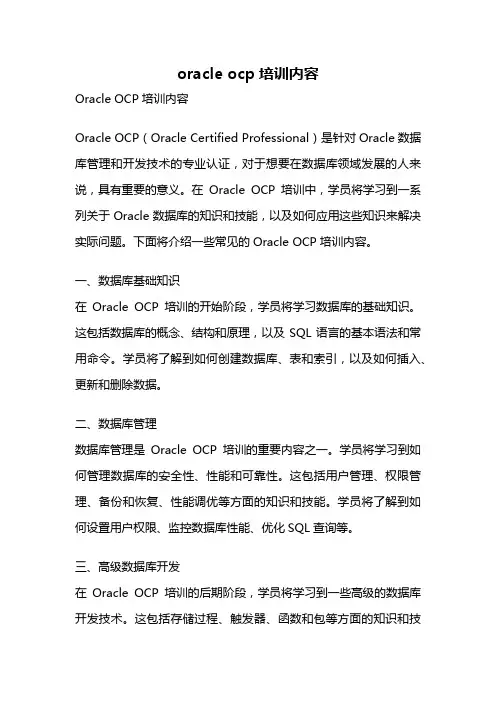
oracle ocp培训内容Oracle OCP培训内容Oracle OCP(Oracle Certified Professional)是针对Oracle数据库管理和开发技术的专业认证,对于想要在数据库领域发展的人来说,具有重要的意义。
在Oracle OCP培训中,学员将学习到一系列关于Oracle数据库的知识和技能,以及如何应用这些知识来解决实际问题。
下面将介绍一些常见的Oracle OCP培训内容。
一、数据库基础知识在Oracle OCP培训的开始阶段,学员将学习数据库的基础知识。
这包括数据库的概念、结构和原理,以及SQL语言的基本语法和常用命令。
学员将了解到如何创建数据库、表和索引,以及如何插入、更新和删除数据。
二、数据库管理数据库管理是Oracle OCP培训的重要内容之一。
学员将学习到如何管理数据库的安全性、性能和可靠性。
这包括用户管理、权限管理、备份和恢复、性能调优等方面的知识和技能。
学员将了解到如何设置用户权限、监控数据库性能、优化SQL查询等。
三、高级数据库开发在Oracle OCP培训的后期阶段,学员将学习到一些高级的数据库开发技术。
这包括存储过程、触发器、函数和包等方面的知识和技能。
学员将了解到如何使用PL/SQL语言来编写复杂的数据库逻辑和业务规则。
四、高可用性和故障恢复高可用性和故障恢复是Oracle数据库管理的重要内容。
在Oracle OCP培训中,学员将学习到如何配置和管理Oracle数据库的高可用性解决方案,以及如何进行故障恢复。
学员将了解到如何配置数据保护、故障转移和灾备解决方案,以及如何应对数据库故障和灾难。
五、性能调优性能调优是Oracle数据库管理的关键技能之一。
在Oracle OCP培训中,学员将学习到如何识别和解决数据库性能问题。
学员将了解到如何使用Oracle性能监视工具和诊断工具,以及如何优化SQL 查询、调整数据库参数和配置硬件资源。
六、安全管理数据库安全管理是Oracle OCP培训的重要内容之一。
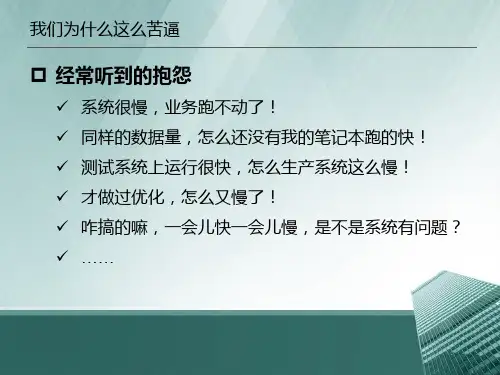
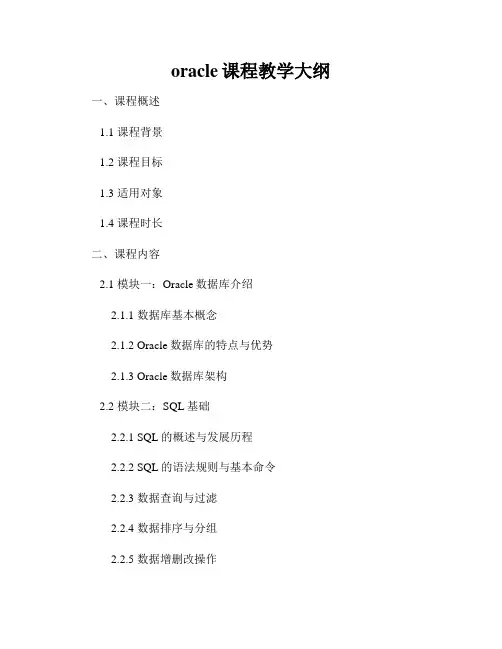
oracle课程教学大纲一、课程概述1.1 课程背景1.2 课程目标1.3 适用对象1.4 课程时长二、课程内容2.1 模块一:Oracle数据库介绍2.1.1 数据库基本概念2.1.2 Oracle数据库的特点与优势2.1.3 Oracle数据库架构2.2 模块二:SQL基础2.2.1 SQL的概述与发展历程2.2.2 SQL的语法规则与基本命令2.2.3 数据查询与过滤2.2.4 数据排序与分组2.2.5 数据增删改操作2.3 模块三:PL/SQL编程2.3.1 PL/SQL的概述与特点2.3.2 PL/SQL的语法规则与基本结构 2.3.3 变量与数据类型2.3.4 控制流程与条件语句2.3.5 异常处理与事务控制2.4 模块四:高级数据库应用2.4.1 触发器与存储过程2.4.2 游标与游标变量2.4.3 动态SQL与游标FOR循环2.4.4 PL/SQL包与函数2.4.5 数据库调优与性能优化2.5 模块五:数据备份与恢复2.5.1 数据库备份策略与方法2.5.2 数据库恢复与故障处理2.5.3 数据库容灾与高可用性三、教学方法与学习资源3.1 教学方法3.1.1 理论讲解3.1.2 实例演示3.1.3 实践操作3.1.4 课堂讨论3.2 学习资源3.2.1 教材推荐3.2.2 在线文档与教程3.2.3 实验环境与工具四、考核要求4.1 平时作业4.2 实验报告4.3 期中考试4.4 期末论文五、参考书目六、教师简介七、备注这是一个基于Oracle数据库的课程大纲,旨在为学生提供全面而系统的Oracle数据库知识和技能。
通过该课程的学习,学生将掌握Oracle数据库的基本概念、SQL语言的使用、PL/SQL编程技术、高级数据库应用等方面的知识,并具备数据库备份与恢复的能力。
本课程分为五个模块,依次介绍了Oracle数据库的基础知识、SQL语言的使用、PL/SQL编程技术、高级数据库应用和数据备份与恢复等内容。
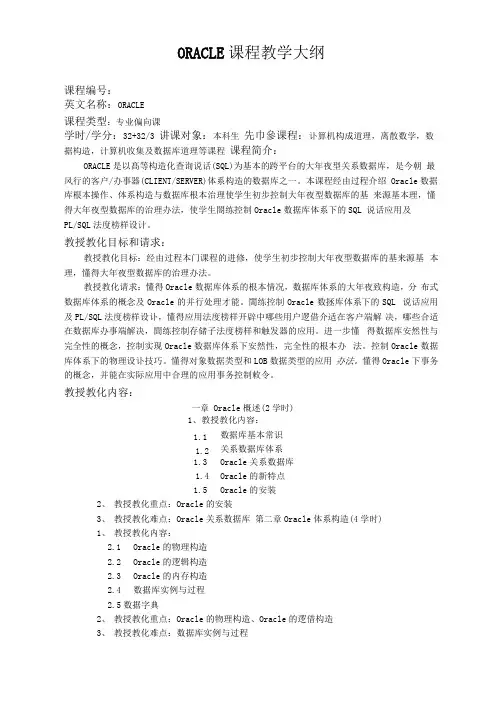
ORACLE课程教学大纲课程编号:英文名称:ORACLE课程类型:专业偏向课学时/学分:32+32/3 讲课对象:本科生先巾參课程:讣算机构成道理,离散数学,数据构造,计算机收集及数据库道理等课程课程简介:ORACLE是以髙等构造化查询说话(SQL)为基本的跨平台的大年夜型关系数据库,是今朝最风行的客户/办事器(CLIENT/SERVER)体系构造的数据库之一。
本课程经由过程介绍 Oracle数据库根本操作、体系构造与数据库根本治理使学生初步控制大年夜型数据库的基来源基本理,懂得大年夜型数据库的治理办法,使学生閤练控制Oracle数据库体系下的SQL 说话应用及PL/SQL法度榜样设计。
教授教化目标和请求:教授教化目标:经由过程本门课程的进修,使学生初步控制大年夜型数据库的基来源基本理,懂得大年夜型数据库的治理办法。
教授教化请求:懂得Oracle数据库体系的根本情况,数据库体系的大年夜致构造,分布式数据库体系的概念及Oracle的并行处理才能。
闇练控制Oracle数拯库体系下的SQL 说话应用及PL/SQL法度榜样设讣,懂得应用法度榜样开辟中哪些用户逻借介适在客户端解决,哪些合适在数据库办事端解决,閭练控制存储子法度榜样和触发器的应用。
进一步懂得数据库安然性与完全性的概念,控制实现Oracle数据库体系下安然性,完全性的根本办法。
控制Oracle数据库体系下的物理设讣技巧。
懂得对象数据类型和LOB数据类型的应用办法。
懂得Oracle下事务的概念,并能在实际应用中合理的应用事务控制敕令。
教授教化内容:一章 Oracle概述(2学时)1、教授教化内容:1.1 数据库基本常识1.2 关系数据库体系1.3 Oracle关系数据库1.4 Oracle的新特点1.5 Oracle的安装2、教授教化重点:Oracle的安装3、教授教化难点:Oracle关系数据库第二章Oracle体系构造(4学时)1、教授教化内容:2.1Oracle的物理构造2.2Oracle的逻辑构造2.3Oracle的内存构造2.4数据库实例与过程2.5数据字典2、教授教化重点:Oracle的物理构造、Oracle的逻借构造3、教授教化难点:数据库实例与过程第三章SQL说话基本(6学时)1、教授教化内容:3.1 SQL简介3.2 SQL的根本语法3.3 数据査询说话3.4 数据把持说话3.5 数据立义说话3.6 数据控制说话3.7 常用函数2、教授教化重点:数据查询说话、数据把持说话. 据控制说数据左义说话、数话3、教授教化难点:SQL的根本语法第四章PL/SQL编程(8学时)1、教授教化内容:4.1 PL/SQL简介4.2 PL/SQL的语法4.3 存储过程4.4 触发器4.5 游标4.6 包4.7 函数2、教授教化重点:PL/SQL的语法3、教授教化难点:触发器、游标第五章Oracle数据库治理(4学时)K教授教化内容:5.1 Oracle数据库治理简介5.2 创建、启动和封闭Oracle数据库5.3 治理表空间5.4 治理Oracle数据文件5.5 治理重做日记文件5.6 治理Oracle数据库对象2、教授教化重点:创建、启动和封闭Oracle数据库3、教授教化难点:治理重做日记文件第六章备份与恢复的安然治理(4学时)K教授教化内容:6.1 Oracle9i的安然保障机制6.2 用户治理6.3 权限和角色6.4 概要文件6.5 数据文件2、教授教化重点:权限和角色3、教授教化难点:权限和角色第七章数据库的备份与恢复(2学时)1、教授教化内容:7.1 备份与恢复概述7.2 物理备份与恢复7.3 逻辑备份与恢复7.4 高等复制手技巧7.5 恢复治理器7.6 Oracle灾害恢复解决筹划7.7 备份与恢复策略2、教授教化重点:物理备份与恢复、逻借备份与恢复3、教授教化难点:备份与恢复策略第八章Oracle9i常用对象(2学时)1、教授教化内容:8.1SQL*Plus交互式应用法度榜样8.2SQL*Plus Worksheet全屏幕开辟情况8.3Oracle企业治理器8.4移植对象8.5设备收集治理对象8.6机能检测器2、教授教化重点:SQL*Plus交互式应用法度榜样、SQL*Plus Worksheet 全屏幕开辟情况3、教授教化难点:Oracle企业治理器实验内容:实验一、Oracle的安装和启动SQL*PLUS ( 2学时)1、实验目标:控制若何安装0RACLE9I以及若何设备0RACLE9I收集情况,控制SQL*PLUS的安装。
OCM说明面向个人市场的Oracle职业教育项目(WDP) 面授天数报名价格(元)适用对象及办学特色必选课程OCM 考试简介和Oracle10g 服务器考试环境配置OCP强化2 2,780课程一Oracle10g数据可用性实现Backup and Recovery2 2,980 课程二Oracle 数据管理/数据仓库Data WarehouseFoundmental + Implement and Administer aData Warehouse + Advance Replication4 5,580课程三Oracle10g GRID CONTROL2 2,980课程四Oracle 关键业务数据容灾Data Guard3 4,280课程五Oracle 性能优化Performance Tuning5 6,980课程大纲(最低要求是2门课程培训记录)课程六Oracle 数据库集群 RAC 3 4,280资深OCM大师/Oracle实战技术大师真机实验辅导,Oracle University官方权威认可的全球职业教育项目(),面向中国区个人市场全面培养Oracle技术人才。
■ Oracle University官方鼎力支持, Oracle University北亚区吴总、中国区林总亲临支持;■ Oracle University指导设计全套课程体系,教学覆盖全部数据库管理技能及全部OCM考试知识点;■中国电信机房内顶级Oracle实验室配置, Unix/Linux/Solaris真机系统,徐家汇/江苏路顶级地段地铁写字楼内设教室,豪华软硬件学习环境,彰显办学实力;■ OCM大师/Oracle实战技术大师传授实践Oracle网格系统运维和服务中的管理经验,包括网格/RAC系统的安装升级迁移、巡检、健康检查、故障排除、服务响应、调优等;■提高和检验你的Oracle功底,全面剖析OCM认证考试上机试题重点与疑难点,其中网格部分是OCM认证的核心考点,包括Grid Control、多节点RAC、Data Guard多级灾备、物化视图等,帮助你高效应对OCM考试;■ Oracle University官方OCM权威教材,非市场上盗版之流;■加入Oracle Club,与Oracle技术大师一起畅快交流,建立人脉圈,提升个人职业竞争力;- 考前辅导 4 6,500 全面复习、巩固教学内容,OCM模拟考试OracleOCM考试Oracle公司OCM考试一次 2 7,649 Oracle University在上海、北京举行组织考试,每场最大考试人数8人课程大纲:1. Oracel10g服务器考试环境配置通过本课程使得数据库工程技术人员能够了解OCM考试形式、时间安排和注意事项,帮助学员掌握手工创建数据库和表空间,配置数据库监听器等任务课程内容:1)手工创建数据库2)确定和设置有关数据库初始化的参数3)创建表空间4)创建与管理复用控制文件5)打文件表空间管理6)创建与管理多网络配置文件7)监听器配置8)共享数据库服务器的监听器配置9)配置数据库动态监听10)管理Oracle网络监听进程11)数据库初始化参数、临时、永久、UNDO表空间初始设置最佳实践工具软件:Oracle10g Database、Listener、SQL/PLUS2. Oracle 10g Grid ControlOracle 10g Grid Control是Oracle公司提供的一种企业级数据库(数据库节点数在几十台以上的规模)部署,管理和监控的解决方案。
Oracle数据库职业直通车近年来,Oracle数据库无疑是全球数据库领域中的领航者,Oracle DBA的待遇节节攀升,导致了许多人希望转入这个行业。
而Oracle数据库又因它的庞大和复杂另很多人望而却步,找不到入门的捷径。
本课程是专门为在校同学定制的一门课程,你基本上不需要有任何数据库的知识就可以参加学习,课程会从最基本的数据库知识讲起,强调循序渐进,不会直接深入到一个具体的技术,随着课程的深入,一些基本的概念和技术会慢慢渗透进来,最后会使学员对Oracle不再陌生,不再恐惧,可以非常从容的,思路清晰进行后续的深入学习。
这门课强调课程的连续性和循序渐进性,让学员不会感受到技术的孤岛,使所有学到的东西都可以串成一条线,为以后的深入学习打下牢固的基础。
尽管这是一门入门级的课程,但我们仍然请到了一位在Oracle领域工作超过10年的教师来讲授这门课,他就是谭怀远(网名alantany),它是两本Oracle数据库畅销书《让Oracle跑得更快——Oracle 10g性能分析与优化思路》和《让Oracle跑得更快——基于海量数据的数据库设计与优化》的作者。
他的教学风格犹如他的著作,擅长于深入浅出得阐释各种复杂的概念,把繁杂的知识整理为体系化的内容,前后相承有序,理论联系实际,有点有面,使到学习者更容易理解吸收。
实际上大家都应该有这样的经验,对某种东西理解越深的人,他讲解它的时候,反而更加的通俗易懂和生动有趣,这是我们设立课程的目的,以一种非常负责任的态度来授课,不会轻视任何一个学员。
课程的目的和机会完成本课程,你将能够信心满满的参加Oracle相关工作的面试,真正进入Oracle数据库领域。
《Oracle数据库职业直通车》课程内容如下:准备课程:Oracle的就业,认证和职业规划第1课轻松带你走进Oracle数据库的世界第2课从最简单的SQL语句开始第3课 Oracle数据库的安装和配置第4课 oracle数据库的参数文件,控制文件,数据文件和日志文件第5课 Oracle体系架构简述第6课 Oracle数据库的对象(1)第7课 Oracle数据库的对象(2)第8课复杂一些的SQL语句第9课学写存储过程和函数第10课数据字典第11课数据库的备份和恢复第12课DBA日常工作内容和职责第13课Oracle的内存结构与后台进程第14课重做日志和日志挖掘第15课回滚段及其用途第16课深入了解数据块第17课ASM管理第18课Oracle的备份恢复及数据迁移。
《ORACLE》课程教学大纲课程编号:英文名称:ORACLE课程类型:专业方向课学时/学分:32+32/3授课对象:本科生先修课程:计算机组成原理,离散数学,数据结构,计算机网络及数据库原理等课程课程简介:ORACLE 是以高级结构化查询语言(SQL)为基础的跨平台的大型关系数据库,是目前最流行的客户/服务器(CLIENT/SERVER)体系结构的数据库之一。
本课程通过介绍Oracle数据库基本操作、体系结构与数据库基本管理使学生初步掌握大型数据库的基本原理,了解大型数据库的管理方法,使学生熟练掌握Oracle数据库系统下的SQL语言运用及PL/SQL程序设计。
教学目的和要求:教学目的:通过本门课程的学习,使学生初步掌握大型数据库的基本原理,了解大型数据库的管理方法。
教学要求:了解Oracle数据库系统的基本情况,数据库系统的大致结构,分布式数据库系统的概念及Oracle的并行处理能力。
熟练掌握Oracle数据库系统下的S Q L语言运用及PL/SQL程序设计,了解应用程序开发中哪些用户逻辑适宜在客户端解决,哪些适宜在数据库服务端解决,熟练掌握存储子程序和触发器的使用。
进一步了解数据库安全性与完整性的概念,掌握实现Oracle数据库系统下安全性,完整性的基本方法。
掌握Oracle数据库系统下的物理设计技术。
了解对象数据类型和LOB数据类型的使用方法。
理解Oracle 下事务的概念,并能在实际应用中合理的使用事务控制命令。
教学内容:第一章Oracle概述(2学时)1、教学内容:1.1数据库基础知识1.2关系数据库系统1.3Oracle关系数据库1.4Oracle的新特性1.5Oracle的安装2、教学重点:Oracle的安装3、教学难点:Oracle关系数据库第二章O racle体系结构(4学时)1、教学内容:2.1Oracle的物理结构2.2Oracle的逻辑结构2.3Oracle的内存结构2.4数据库实例与进程2.5数据字典2、教学重点:Oracle的物理结构、Oracle的逻辑结构3、教学难点:数据库实例与进程第三章S QL语言基础(6学时)1、教学内容:3.1SQL简介3.2SQL的基本语法3.3数据查询语言3.4数据操纵语言3.5数据定义语言3.6数据控制语言3.7常用函数2、教学重点:数据查询语言、数据操纵语言、数据定义语言、数据控制语言3、教学难点:SQL的基本语法第四章P L/SQL编程(8学时)1、教学内容:4.1PL/SQL简介4.2PL/SQL的语法4.3存储过程4.4触发器4.5游标4.6包4.7函数2、教学重点:PL/SQL的语法3、教学难点:触发器、游标第五章O racle数据库管理(4学时)1、教学内容:5.1Oracle数据库管理简介5.2创建、启动和关闭Oracle数据库5.3管理表空间5.4管理Oracle数据文件5.5管理重做日志文件5.6管理Oracle数据库对象2、教学重点:创建、启动和关闭Oracle数据库3、教学难点:管理重做日志文件第六章备份与恢复的安全管理(4学时)1、教学内容:6.1Oracle9i的安全保障机制6.2用户管理6.3权限和角色6.4概要文件6.5数据文件2、教学重点:权限和角色3、教学难点:权限和角色第七章数据库的备份与恢复(2学时)1、教学内容:7.1备份与恢复概述7.2物理备份与恢复7.3逻辑备份与恢复7.4高级复制手技术7.5恢复管理器7.6Oracle灾难恢复解决方案7.7备份与恢复策略2、教学重点:物理备份与恢复、逻辑备份与恢复3、教学难点:备份与恢复策略第八章O racle9i常用工具(2学时)1、教学内容:8.1SQL*Plus交互式应用程序8.2SQL*Plus Worksheet全屏幕开发环境8.3Oracle企业管理器8.4移植工具8.5配置网络管理工具8.6性能检测器2、教学重点:SQL*Plus交互式应用程序、SQL*Plus Worksheet全屏幕开发环境3、教学难点:Oracle企业管理器实验内容:实验一、Oracle的安装和启动SQL*PLUS(2学时)1、实验目的:掌握如何安装ORACLE9I以及如何配置ORACLE9I网络环境,掌握SQL*PLUS的安装。
oracle教学大纲Oracle教学大纲引言:Oracle是一种关系型数据库管理系统(RDBMS),被广泛应用于企业级应用中。
本文将探讨Oracle教学的大纲,旨在帮助学习者了解Oracle的基本概念、架构和常用功能,以及如何进行数据库设计、查询和管理。
一、Oracle概述1.1 Oracle的历史和发展1.2 Oracle的特点和优势1.3 Oracle的应用领域和市场地位二、Oracle架构2.1 Oracle的体系结构概述2.2 Oracle实例和数据库的关系2.3 Oracle的内存结构和进程模型2.4 Oracle的存储结构和文件组织三、Oracle数据库设计3.1 数据库设计的基本原则和步骤3.2 数据库模型和关系模型3.3 数据库范式和反范式设计3.4 数据库表的创建和管理四、Oracle SQL基础4.1 SQL语言的概述和分类4.2 SQL语句的基本结构和语法4.3 数据查询和过滤4.4 数据排序和分组4.5 数据修改和删除五、Oracle高级SQL5.1 多表查询和连接操作5.2 子查询和嵌套查询5.3 聚合函数和分组查询5.4 视图和索引的使用5.5 数据库安全和权限管理六、Oracle数据管理6.1 数据库备份和恢复6.2 数据库性能优化和调优6.3 数据库监控和故障处理6.4 数据库迁移和升级七、Oracle应用开发7.1 Oracle开发工具和环境7.2 PL/SQL语言和存储过程7.3 数据库触发器和事件处理7.4 数据库连接和事务管理八、Oracle的扩展功能8.1 数据库分区和分表8.2 数据库集群和高可用性8.3 数据库安全和加密8.4 数据库性能监控和优化结语:通过本教学大纲,学习者将能够全面了解Oracle数据库的基本概念、架构和常用功能。
他们将学会如何进行数据库设计、查询和管理,以及应用开发和性能调优。
掌握Oracle技术,将为学习者在企业级应用开发和数据库管理领域提供广阔的发展空间。
华尔思OCM 直通车课程内容Oracle Database 11g: SQL Fundamentals I 课程(2天)1. 使用简单的SELECT 语句2. 限定及排序选择的行3. 单行函数4. 多表查询5. 分组功能6. 子查询7. 使用集合操作符8. 使用DML 语句9. 使用DDL 语句创建和管理表10. 创建和管理其它的模式对象Oracle Database 11g: Administration Workshop I 课程(5天)1. oracle 数据库的体系结构2. 安装oracle 软件3. dbca 创建数据库4. 管理oracle 实例5. 管理ASM 实例6. 配置oracle 网络环境7. 数据并发与控制 w w w .w a l l sl a b .n e t8. 管理UNDO 数据9. 实施oracle 数据库的审计10. 数据库的前瞻性维护11. 性能管理12. 备份恢复的概念13. 执行用户管理的备份14. 执行用户管理的恢复15. 数据的迁移Oracle Database 11g: Administration Workshop II 课程(5天)1. 配置oracle 数据库的恢复能力2. 使用恢复目录3. 配置备份设置4. 创建RMAN 备份5. 转储和恢复任务6. 使用RMAN 完成恢复7. 监视和调整RMAN8. 诊断数据库9. 使用闪回技术110. 使用闪回技术211. 实施闪回数据库 w w w .w a l l sl a b .n e t12. 管理内存13. 管理数据库的性能14. 通过SQL 调整性能15. 管理资源16. 使用调度17. 管理数据库的存储空间18. 复制数据库OCA 考试(Oracle Database 11g Administrator CertifiedAssociate )总共涉及2门课程 1Z0-051 Oracle Database 11g: SQL Fundamentals I 1Z0-052 Oracle Database 11g : Administration Workshop I第一门课:SQL Fundamentals I 课程内容,考试代号:1Z0-051考试时间:120分钟,64题,60%通过 第二门课:Administration Workshop I ,考试代号:1Z0-052考试时间90分钟,70题,66%通过OCP 考试(Oracle Database 11g Administrator Certified Professional )总共涉及3门课程w w w .w a l l s l a b .n e t1Z0-051 Oracle Database 11g: SQL Fundamentals I1Z0-052 Oracle Database 11g : Administration Workshop I1Z0-053 Oracle Database 11g : Administration Workshop II第三门课:Administration Workshop II ,考试代号:1Z0-053考试时间105分钟,78题,66%通过OCM 考试(Oracle Database 11g Administrator CertifiedMaster ): 条件:通过OCP 考试,然后选择并参加两门高级课程的学习,这两门课的学习需要10天时间。
以下三门课是学员选择最多的、最实用的课程: Oracle Database 11g: Performance Tuning DBAOracle Database 11g: Data Guard AdministrationOracle Database 11g: RAC AdministrationOCM 课程旨在培养Oracle 数据库的资深管理员,考察学员实际动手能力,以及在复杂环境下解决实际问题的能力。
考试方式:在实验室中实际操作,考试时间2天,能否通过取决于实验的完成情况。
Oracle Database 11g: RAC Administration 课程:1. Oracle Clusterware Installationw w w .w a l l s l a b .n e t2. RAC Installation3. Database Creation4. RAC DB Administration5. Backup and Recover a RAC DB6. RAC DB Monitoring and Tuning7. Services8. High Availability of Connections9. Oracle Clusterware Administration10. Diagnosing the Oracle Clusterware components11. Node Addition/Removal12. Design for High Availability13. WorkshopOracle Database 11g: Data Guard Administration 课程:1. Creating a Physical Standby Database by Using SQL and RMAN Commands2. Oracle Data Guard Broker: Overview3. Creating a Data Guard Broker Configuration4. Creating a Physical Standby Database by Using Enterprise Manager Grid Control5. Creating a Logical Standby Database6. Creating and Managing a Snapshot Standby Database7. Using Oracle Active Data Guard8. Configuring Data Protection Modes9. Performing Role Transitions w w w .w a l l sl a b .n e t10. Using Flashback Database in a Data Guard Configuration11. Enabling Fast-Start Failover12. Managing Client Connectivity13. Performing Backup and Recovery Considerations in an Oracle Data GuardConfiguration14. Patching and Upgrading Databases in a Data Guard Configuration15. Monitoring a Data Guard Configuration16. Optimizing a Data Guard ConfigurationOracle Database 11g: Performance Tuning DBA 课程:1. Performance Tuning Introduction2. Monitoring With Basic Tools3. Using Automatic Workload Repository4. Identifying the Problem5. Identifying Problem SQL Statements6. Influencing the Optimizer7. SQL Plan Management8. Change Management9. Using Metrics and Alerts10. Using AWR Based Tools11. Monitoring an Application (Using Services)12. Baselines13. Tuning the Shared Poolw w w .w a l l sl a b .n e t14. Tuning the Buffer Cache15. Tuning PGA and Temporary Space16. Automatic Memory Management17. Tuning Block Space Usage18. Tuning I/O19. Performance Tuning: Summary20. Using Statspack教材推荐Oracle 11g 数据库管理员指南 机械工业出版社 刘宪军编著Oracle RAC 11g 实战指南 机械工业出版社 刘宪军编著Oracle Database Concepts 11g Release 2 (11.2)Oracle Database Administrator's Guide 11g Release 2 (11.2)Oracle Database Backup and Recovery User's Guide 11g Release 2 (11.2)Oracle Data Guard Concepts and Administration 11g Release 2 (11.2)Oracle Real Application Clusters Installation Guide 11g Release 2 (11.2) for Linux and UNIX w w w .w a l l sl a b .n et。